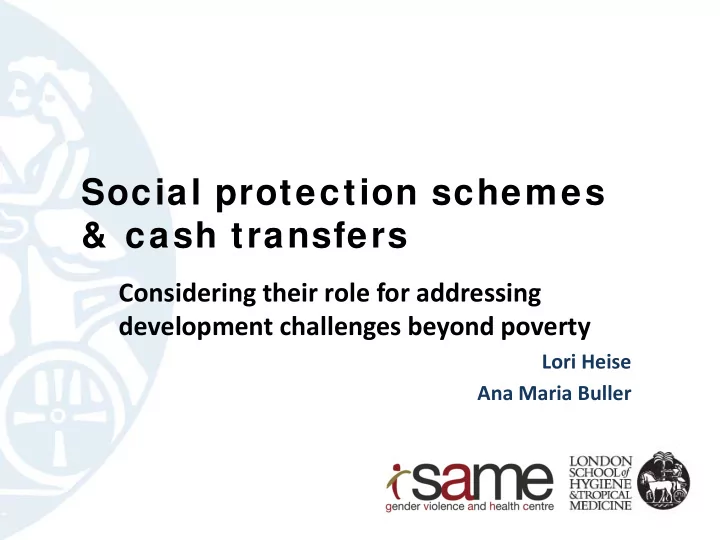

Social protection schemes & cash transfers Considering their role for addressing development challenges beyond poverty Lori Heise Ana Maria Buller
A new “magic bullet”? Increasing interest in using cash transfers to affect a host of • development outcomes from improving child nutrition to keeping girls in school Transfers are generally integrated into countries’ social protection • schemes and may be either conditional or unconditional 37 African countries now have national social protection schemes or • testing pilot transfer schemes • LSHTM staff are engaged in two primary areas: – Assessing impact of CTs on HIV prevention, treatment & care – Assessing impact of CTs on household dynamics and domestic violence
Transfers and HIV Evidence review & questions Two foundational perspectives to be resolved • Poverty alleviation – Reducing structural vulnerabilities that lead to transactional sex and other risky behaviours • Behavioural economics (nudge) – Cash as incentive to discourage risky sex or increase adherence – Bringing benefits of self protection closer in time
Incentivising behaviour Tanzania RCT Lesotho RCT People offered up to $60 each People in treatment arm offered • • annually to stay STI ‐ free had 25% chance to win lottery prize every lower STI prevalence (De Walque four months if they remained STI et al 2012) negative ($150 vs $75) Level of the cash relative to SES After two years, HIV incidence • • important decreased by 27% in the lottery compared to the control arm Effects bigger with higher • incentives and among low SES – 31% among women households – 38% in the high lottery arm
Reducing vulnerability Zomba Malaw i
Transfers and IPV What does theory predict? • Cash will increase women’s Household bargaining power thereby Bargaining Theory reducing IPV • Given hierarchical gender Backlash Theory relations, cash will increase IPV, at least in short term
Transfers and IPV What does previous research suggest? • Give Directly Project in Kenya – RTC of unconditional cash transfer through cell phones – Transfers lead to a 30 ‐ 50% reduction in reports of physical IPV and a 50 ‐ 60% reduction in reports of rape within the marriage. – Effects larger when the transfer went to the woman, but some reduction in IPV even when the transfer went to the man.
Transfers and IPV What does previous research suggest? • In Mexico’s Opportunidades programme, Bobonis found that in the short term, risk of physical IPV � 33%, but emotional abuse and threats � 60% • 5 ‐ 9 years later physical and emotional abuse no longer differed significantly among beneficiary and non ‐ beneficiary couples • Question for future studies: How long are effects sustained over time?
“Cash, Food and Voucher” trial RCT implemented by the World Food • Program. Between April – September 2011 in • urban centers with high Colombian refugee populations in the provinces of Carchi and Sucumbíos in Northern Ecuador. 6 transfers (one per month). • As part of the intervention they were • invited to nutrition workshops. All transfer modalities were • equivalent to $40 (11% of pre ‐ transfer HH income)
Our study: Expanding Lessons from a Randomized Impact Evaluation of Cash and Food Transfers in Ecuador Overall aim: • To understand how transfers impact intra ‐ household conflict and domestic violence. Design: • Mixed methods including quantitative and qualitative components. Qualitative Sample • Purposively sampled according to changes in DV from baseline to follow up. • 48 interviews with women • 8 FG: 2 with women, 6 with men.
Preliminary quantitative results On average, transfers decreased controlling behaviours, moderate • physical and any physical/sexual partner violence by 6 to 7 percentage points (~ 38 ‐ 44% decline) Effect did not vary significantly by transfer modality • Decreases in IPV are concentrated among women with low decision ‐ • making power at baseline. Among these low ‐ power women, vouchers and food reduced IPV • more than cash Conclusion: In certain settings, transfers may work to equalize power • dynamics in households with high levels of initial inequity
Preliminary qualitative results Transfer seemed to reduce stress, relationship tension and • embarrassment about food insecurity I: why did it improve (the relationship)? Elena: because I did not have to be asking for money for the rice, that was over. For him it was a bit embarrasing and I also used to feel bad, because I was asking all the time, ‘give me something for the rice, for the oil’ knowing that he did not have enough money…. Women administered transfer regardless of whether it was given to • woman or man (women in charge of cooking/nutrition) Framing as “nutrition project” may have reduced backlash ‐‐ transfer • did not challenge traditional gender roles
Empow ering women or reinforcing existing gender roles? But... are we really empowering them or are we unintentionally • perpetuating gender roles? (i.e. women deal with cooking and household matters) Would it be different if the transfers were about education for • women rather than food for the family? Should we be open to accommodating existing gender norms to • achieve short term gains or does this fundamentally compromise our long term goal of tackling gender inequalities at the base of violence? What about sustainability? •
Other LSHTM projects on transfers PhD Meghna Ranganathan: • – Exploring the role that cash transfers may play on reducing transactional sex (and hence HIV vulnerability) among adolescent girls in the Swa ‐ Koketa CCT trial in rural South Africa Economics group • – Systematic review of the effect of financial incentives on the uptake of HIV services – Input into RCT that will test the relative impact of lottery/transport voucher/cash on linking people who test positive through self ‐ testing to HIV care Aurelia Lepine (Fellowship): • – Test the relative impact of lottery and cash payment on adherence to PrEP in Nigeria Heise and Buller • – Systematic review of the impact of transfers on risk of partner violence
Recommend
More recommend